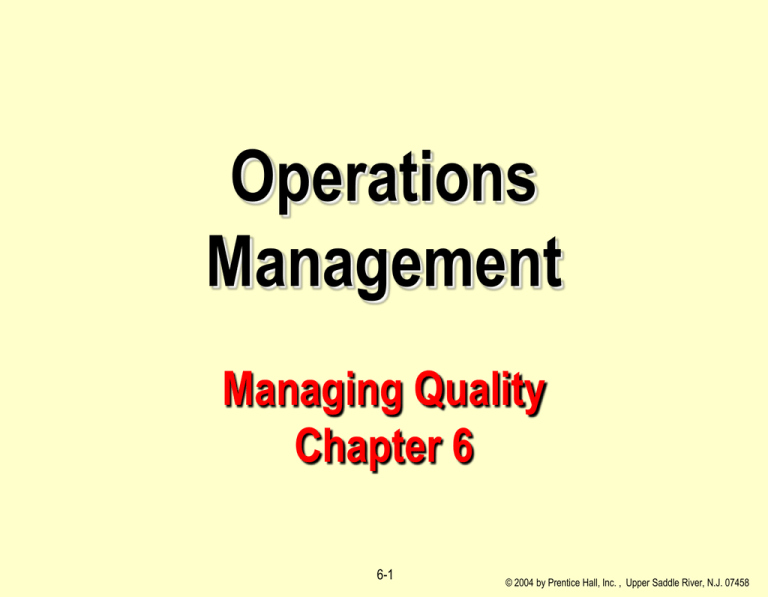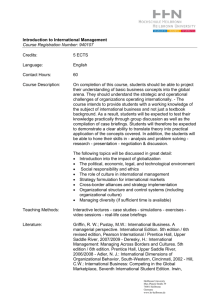Chapter 6 Heizer/Render, 5th and 7th edition
advertisement

Operations Management Managing Quality Chapter 6 6-1 © 2004 by Prentice Hall, Inc. , Upper Saddle River, N.J. 07458 Ways Quality Can Improve Profitability Sales Gains Improved response Higher Prices Improved reputation Improved Quality Reduced Costs Increased Profits Increased productivity Lower rework / scrap costs Lower warranty costs 6-2 © 2004 by Prentice Hall, Inc. , Upper Saddle River, N.J. 07458 Flow of Activities Necessary to Achieve Total Quality Management Organizational Practices Quality Principles Employee Fulfillment Customer Satisfaction 6-3 © 2004 by Prentice Hall, Inc. , Upper Saddle River, N.J. 07458 TQM – Organizational Practices Organizational Practices Leadership Mission statement Quality Principles Effective operating procedure Employee Fulfillment Staff support Customer Satisfaction Training What is important and what is to be accomplished 6-4 © 2004 by Prentice Hall, Inc. , Upper Saddle River, N.J. 07458 TQM – Quality Principles Customer focus Continuous improvement Employee empowerment Benchmarking Just-in-time Tools of TQM Organizational Practices Quality Principles Employee Fulfillment Customer Satisfaction How to do what is important and to be accomplished 6-5 © 2004 by Prentice Hall, Inc. , Upper Saddle River, N.J. 07458 TQM – Employee Fulfillment Organizational Practices Empowerment Organizational commitment Quality Principles Employee Fulfillment Customer Satisfaction Employees’ attitudes that they can accomplish what is important and to be accomplished 6-6 © 2004 by Prentice Hall, Inc. , Upper Saddle River, N.J. 07458 TQM – Customer Satisfaction Winning orders Repeat customers Organizational Practices Quality Principles Employee Fulfillment Customer Satisfaction An effective organization with a competitive advantage 6-7 © 2004 by Prentice Hall, Inc. , Upper Saddle River, N.J. 07458 Definitions of Quality ASQ: The totality of features and characteristics of a product or service that bears on its ability to satisfy stated or implied needs CATAGORIES User-Based: What consumer says it is Product-Based: Level of measurable product characteristic Manufacturing-Based: Degree to which a product conforms to design specification CONFORMANCE IS THE JOB OF OPERATIONS 6-8 © 2004 by Prentice Hall, Inc. , Upper Saddle River, N.J. 07458 Dimensions of Quality for Goods Operation Reliability & durability Serviceability Appearance Perceived quality Conformance 6-9 © 2004 by Prentice Hall, Inc. , Upper Saddle River, N.J. 07458 Service Quality Attributes Reliability Responsiveness Tangibles Competence Understanding Access Security Courtesy © 1995 Corel Corp. Credibility Communication How do we build quality into our service offerings? 6-10 © 2004 by Prentice Hall, Inc. , Upper Saddle River, N.J. 07458 Costs of Quality Prevention costs Appraisal costs Internal failure costs External failure costs Costs of poor quality are huge but the amounts are not known with precision. In most companies, the accounting system provides only a minority of the information needed to quantify this cost of poor quality Juran on “Quality by Design” The Free Press (1992) 6-11 © 2004 by Prentice Hall, Inc. , Upper Saddle River, N.J. 07458 Prevention Costs Costs associated with preventing defects before they happen Redesigning the process to remove causes of defects Redesigning the product or service Training employees in continuous improvement Working with suppliers to improve quality 6-12 © 2004 by Prentice Hall, Inc. , Upper Saddle River, N.J. 07458 Appraisal Costs Costs to assess / appraise quality Test / inspection to identify quality problems Used to screen out defective product … this is NOT best practice As preventive measures improve quality, appraisal costs decrease 6-13 © 2004 by Prentice Hall, Inc. , Upper Saddle River, N.J. 07458 Internal Failure Costs Costs resulting from defects discovered during production of the product or service Yield / scrap Rework / correcting mistakes (note may also affect delivery) 6-14 © 2004 by Prentice Hall, Inc. , Upper Saddle River, N.J. 07458 External Failure Costs Costs resulting from defects discovered after delivery of the product or service to the customer Warranty service expense Customer returns Dissatisfied customers / repeat business Poor publicity Lawsuits 6-15 © 2004 by Prentice Hall, Inc. , Upper Saddle River, N.J. 07458 Cost of detection and correction Cost of Detecting Defects Prevention, not inspection or correction Process Final testing Customer Where defect is detected 6-16 © 2004 by Prentice Hall, Inc. , Upper Saddle River, N.J. 07458 Traditional Quality Process (Manufacturing) Customer Marketing Engineering Operations Specifies Need Interprets Need Designs Product Produces Product Defines Quality Plans Quality Monitors Quality 6-17 © 2004 by Prentice Hall, Inc. , Upper Saddle River, N.J. 07458 TQM Encompasses entire organization, from supplier to customer Stresses a commitment by management to have a continuing, company-wide, drive toward excellence in all aspects of products and services that are important to the customer. 6-18 © 2004 by Prentice Hall, Inc. , Upper Saddle River, N.J. 07458 Concepts of TQM Continuous improvement Employee empowerment Benchmarking Just-in-time (JIT) Taguchi concepts Knowledge of TQM tools 6-19 © 2004 by Prentice Hall, Inc. , Upper Saddle River, N.J. 07458 TQM CONCEPTS Continuous Improvement Continual improvement of people, equipment, suppliers, materials, process & customer satisfaction Based on philosophy that every aspect of an operation can be improved Plan Involves all operations and work units Other names Act Kaizen Zero-defects Six sigma Do Check 6-20 © 2004 by Prentice Hall, Inc. , Upper Saddle River, N.J. 07458 TQM CONCEPTS Employee Empowerment Involving employees in product & process improvement 85% of quality problems are due to processes & materials The people most closely associated with an operation are in the best position to identify the changes that should be made Techniques Support workers Let workers make decisions Build teams & quality circles Training 6-21 © 2004 by Prentice Hall, Inc. , Upper Saddle River, N.J. 07458 TQM CONCEPTS Benchmarking Selecting best practices in products, services, processes, or costs to use as a standard for performance Determine what to benchmark Form a benchmark team Identify benchmarking partners Collect and analyze benchmarking information Take action to match or exceed the benchmark 6-22 © 2004 by Prentice Hall, Inc. , Upper Saddle River, N.J. 07458 TQM CONCEPTS Best Practices Example – Resolving Customer Complaints Make it easy for clients to complain Respond quickly to complaints Resolve complaints on the first contact Use computers to manage complaints Recruit the best for customer service jobs 6-23 © 2004 by Prentice Hall, Inc. , Upper Saddle River, N.J. 07458 TQM CONCEPTS Just-in-Time (JIT) Relationship to quality: JIT cuts the cost of quality JIT improves quality Better quality means less inventory and better, easier-toemploy JIT system QUALITY JIT 6-24 © 2004 by Prentice Hall, Inc. , Upper Saddle River, N.J. 07458 TQM CONCEPTS Taguchi Concepts Experimental design methods to improve product and process design Quality Robustness – Ability to produce products uniformly regardless of manufacturing conditions – Removing the effects is often cheaper than removing the causes Quality loss function Target specifications 6-25 © 2004 by Prentice Hall, Inc. , Upper Saddle River, N.J. 07458 TQM CONCEPTS Taguchi Concepts Experimental design methods to improve product and process design Quality Robustness Quality loss function – Identifies all costs (loss to society) connected with poor quality – Costs increase as the product moves away from the target High Loss Quality Loss Function Unacceptable Poor Fair Good Best Low Loss Lower Specification Target Upper Target specifications 6-26 © 2004 by Prentice Hall, Inc. , Upper Saddle River, N.J. 07458 Taguchi Concepts TQM CONCEPTS Experimental design methods to improve product and process design Quality Robustness Quality loss function Target-oriented quality – Philosophy of continuous improvement to bring the product exactly on target – Traditional conformanceoriented specs produce more units farther from the target (greater loss) Quality Loss Function (a) High loss Unacceptable Poor Fair Low loss Good Best Conformanceoriented quality keeps product within three standard deviations Frequency Lower 6-27 Target-oriented quality yields more product in the “best” category and brings products toward the target level Upper Target Specification Distribution of specs for product produced (b) © 2004 by Prentice Hall, Inc. , Upper Saddle River, N.J. 07458 Seven Tools of TQM 6-28 TQM CONCEPTS © 2004 by Prentice Hall, Inc. , Upper Saddle River, N.J. 07458 TQM CONCEPTS Process Chart Shows sequence of events in process Depicts activity relationships Has many uses Identify data collection points Find problem sources Identify areas for improvement Identify where travel distances can be reduced Distance 40 94 feet 100 feet 6-29 Time Description Key 60 min. Raw storage Operation 1 min. To drill press Transport 90 min 1 min Wait for Operator to set-up Drill holes Delay / Storage Inspection 1.5 min. De-burring 6 min. Operator set-up 1.3 min. De-burr To lathe © 2004 by Prentice Hall, Inc. , Upper Saddle River, N.J. 07458 TQM CONCEPTS Process Chart example Distance 40 94 feet 100 feet Time Description Key 60 min. Raw storage Operation 1 min. To drill press Transport 90 min 1 min Wait for Operator to set-up Drill holes Delay / Storage Inspection 1.5 min. De-burring 6 min. Operator set-up 1.3 min. De-burr To lathe 6-30 © 2004 by Prentice Hall, Inc. , Upper Saddle River, N.J. 07458 TQM CONCEPTS Cause and Effect Diagram Main Cause Main Cause Specific cause Specific cause Effect Specific cause (problem) Specific cause Specific cause Main Cause Main Cause 6-31 © 2004 by Prentice Hall, Inc. , Upper Saddle River, N.J. 07458 TQM CONCEPTS Cause and Effect Diagram Example Method Manpower Drilling too slow Overtime/ fatigue Wood Lathe not calibrated Steel Material Too many defects Machinery 6-32 © 2004 by Prentice Hall, Inc. , Upper Saddle River, N.J. 07458 6-33 © 2004 by Prentice Hall, Inc. , Upper Saddle River, N.J. 07458 TQM CONCEPTS Inspection Examining items to see if they are good or defective Does not correct deficiencies in process or product Does not add value to the product / service Why inspect – to ensure that we are producing at the expected quality level Issues When to inspect Where in process to inspect 6-34 © 2004 by Prentice Hall, Inc. , Upper Saddle River, N.J. 07458 TQM CONCEPTS When and Where to Inspect At the supplier’s plant while the supplier is producing At your facility upon receipt of goods from the supplier Before costly or irreversible processes During the step-by-step production process When production or service is complete Before delivery from your facility At the point of customer contact The best inspection can be thought of as no inspection at all: Source inspection – controlling or monitoring at the point of production or purchase 6-35 © 2004 by Prentice Hall, Inc. , Upper Saddle River, N.J. 07458 TQM CONCEPTS 100% Inspection vs. SPC Ship Process Rework 100% Inspection Scrap Ship Process Sample Feedback 6-36 SPC (Control Charting) Normal variance or cause for concern © 2004 by Prentice Hall, ? Inc. , Upper Saddle River, N.J. 07458 TQM In Services It is more difficult to measure quality for services than for goods Intangible differences between products (services) Intangible expectations of customers Reliability Tangibles Understanding Security Responsiveness Competence Access Courtesy © 1995 Corel Corp. Credibility 6-37 Communication © 2004 by Prentice Hall, Inc. , Upper Saddle River, N.J. 07458 Operations Role in Service Quality The tangible component of many services is important Operations can design processes (service products) that have quality attributes Customers’ perceptions are the quality standard – Operations can influence both the quality of the service and the expectation Preparation for exceptions – contingency plans for sub-optimal operating conditions 6-38 © 2004 by Prentice Hall, Inc. , Upper Saddle River, N.J. 07458 Summary TQM is a supply chain-wide philosophy to continuously improve processes to make products that will satisfy our customers. TQM and Just-in-Time support each other In the process of getting better, most companies also reduce costs and lead time through elimination of waste. So TQM is a way to get faster, better and cheaper simultaneously. 6-39 © 2004 by Prentice Hall, Inc. , Upper Saddle River, N.J. 07458






